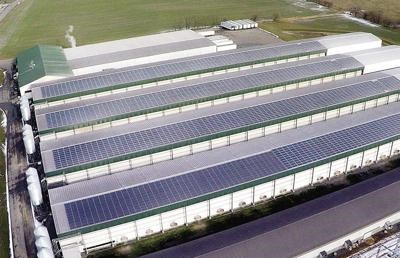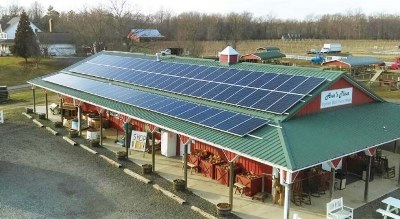Local Solar Facility Siting Ordinances

Many local goverments seek to protect scenic views as part of
local solar facility siting ordinances.
Note: to access the county codes discussed in the following case study, we recommend that you access the Smart DG+ County Zoning Guide at dnr.maryland.gov/pprp/Pages/smartdg.aspx.
Solar Facility Siting Case Study
Jurisdiction: Queen Anne's County
Type: Utility-Scale, Undeveloped Land
Zoning Used: Overlay District
Process: Stakeholder-Driven
Description of Process:
The county asked the solar industry to identify the area of the county of interest to them. The solar industry identified the area two miles from the 69-kV transmission line that extends north to south in the county. Using the Smart DG+ tool from the Maryland Department of Natural Resources (DNR) Power Plant Research Program (PPRP), county staff created an overlay map to inform its public outreach effort. One benefit of the map is that it showed the public that not all lands in the county were of interest to the solar industry (such as the areas adjacent to 34.5 kV transmission lines).
Next, the county subtracted all restricted lands from that area, including easements, wetlands, etc.
Given that most of Queen Anne's County has prime farmland (Class I and II soils), the county wanted to identify a method that could limit the potential loss of farmland in the county. The county chose a payment in lieu of taxes (PILOT) program, up to a cumulative total of 2,000 acres, that provides solar developers the option for negotiated payments in lieu of taxes. After those 2,000 acres are developed, new solar infrastructure would only have the option to be taxed.
Also, in response to concerns from residents regarding impacts to scenic views, the county required aggressive landscaping, berms, and setbacks (75 feet from any property line; 100 feet from any road or right of way, unless a larger setback is required; and 300 feet from any single family, cluster, or sliding scale lot). After five years, the landscaping must completely hide the solar panels from public view. Additional county landscape requirements for utility-scale solar projects include:
- To the maximum extent practicable, solar arrays must be sited using natural topography and vegetation to buffer it from the view of adjacent properties and roads and/or rights-of-way;
- Applicants must provide a detailed landscape plan, which may be a combination of plantings, existing vegetation, fencing, berms, and at a minimum shows the following:
- A vegetated buffer that is a minimum of 50 feet wide around the perimeter of the site area of the utility-scale solar array. This buffer may be located within the required setback.
- Existing healthy vegetation within the required buffer area may be used to satisfy the specific buffer standards.
- A minimum 50% of the landscaping shall be installed prior to initial certificate of occupancy.
- The vegetation shall visually screen the solar array from all adjacent residential uses and zones, from publicly traveled ways (public roads, trails, waterways, scenic highways, and byways), publicly owned properties, open space, preserved farms, and historic resources.
- Native plant species are recommended. Nonnative plant species shall not total more than 50% of all plantings. Invasive species shall not be permitted.
- To ensure adequate variety, and avoid monotony and uniformity within the buffer, plant materials shall not include more than 25% of any single species. Plantings, detailed in a plant schedule on the plan, shall include a mix of evergreen and deciduous trees, understory trees, shrubs, and flowering herbaceous layer.
- A landscape berm, a minimum of three feet high to assist in screening, may be required. The requirement of providing a berm will be evaluated by staff, may be recommended by the Planning Commission, but finally determined by the Board of Appeals.
- Irrigation shall be provided for maintaining plant materials in a healthy condition for all newly created landscape buffer areas.
- The irrigation system shall be designed to prevent runoff, low head drainage, overspray, or other similar conditions where irrigation water flows onto non-targeted areas such as adjacent properties, roadways, or structures.
- A maintenance agreement shall be provided with a surety or other financial assurance to cover replacement of the plantings and/or irrigation system for any failed plantings and/or irrigation system. All plantings shall be maintained in a live, healthy condition for the duration of the solar array use and shall be replaced by the solar array operator or owner as necessary to maintain all required screening.
Best Practices Identified by Queen Anne's County:
Including all stakeholders (e.g., concerned residents, solar industry) during policy development allowed the county to identify the different needs. With this information, the county shaped a policy that best met the interests of as many groups as possible.
Specifics Regarding Zoning Ordinance:
Queen Anne's County created a Utility Scale Solar Array Overlay District.1 For a map of the overlay, see qac.org/DocumentCenter/View/9333/USSA-Overlay-Map?bidId=. The overlay covers all county lands "that are within two miles of electric transmission lines with a capacity of at least 69KV...."2
A "Utility Scale Solar Array" is defined as "a commercial production facility that converts sunlight into electricity, via photovoltaics or various other solar technologies on typically ground-mounted systems, for the purpose of wholesale or retail sale of generated electricity to a utility company and off-site customers."3

Solar panels on poultry houses help reduce consumption of productive farmland for energy production.
They are prohibited on land covered by a conservation or open space easement, "on a parcel within a greenbelt designation or a municipal growth area as identified in the 2010 Queen Anne's County Comprehensive Plan as amended or a Queen Anne's County municipality's community plan," and "on a parcel reconfigured through administrative subdivision for the purpose of adding additional acreage to the area available for Utility Scale Solar Arrays."4 If the Public Service Commission (PSC) requires it, solar arrays must also obtain a certificate of public convenience and necessity (CPCN).
Solar arrays are allowed only in the Agricultural (AG) District and Countryside (CS) District, as conditional uses. Section S of § 18:1-95: Additional standards for specified conditional uses apply to solar arrays.
The county's purpose and goals for the ordinance are described in § 18:1-95, Section S as follows:
"Purpose and intent. The purpose of this subsection is to establish guidelines for the siting of a utility-scale solar array and accessory equipment, buildings or facilities that generate, maintain, operate, manage, store, distribute and transmit power, other than facilities designed for small-scale solar array applications.
(a) The goals of this subsection are to:
[1] Protect existing residential areas and land uses from potential adverse impacts, while accommodating utility-scale solar arrays in the County's Solar Array Overlay Map.
[2] Encourage the configuration of solar arrays so that adverse visual impacts are minimized through careful design, siting, and landscaping screening and buffering.
[3] Encourage the configuration of solar arrays so that the health, safety, and general welfare of the public are protected."
A special application is presented to the Planning Commission at a public meeting. The Commission has 60 days to submit its report and recommendations to the Board of Appeals. The application must include submission requirements, such as:
- Grading, stormwater management, and other engineering drawings.
- The proposed location of equipment and/or storage structures, shelters, landscaping, and site access.
- Documentation of historic structures or heritage and cultural resources. If a project uses federal or state monies, a Section 106 review "shall be filed. The utility-scale solar array shall minimize adverse impacts to viewsheds of designated historic sites and scenic corridors, and further, shall not be located in a scenic byway."
- Information on lighting, signage, circulation, trip generation, setbacks, fencing, noise, screening of the facility, landscaping, etc.
- Compliance with the Forest Conservation Act, identification of vegetation, natural resources, soil types, flood areas, etc.
- Procedures for decommissioning and abandoning the facilities.
If the Planning Commission approves the plan, then the Commission recommends that the Board of Zoning Appeals (BOA) grant a conditional use. If the conditional use is granted, the applicant continues the process by developing a fully engineered Major Site Plan. In addition to the information required on the Major Site Plan all standards found in the Queen Anne's County Zoning & Subdivision Regulations § 18:1-95.S. must be addressed. The Major Site Plan is reviewed and must be approved by the Queen Anne's County Planning Commission. The Planning Commission will review the plan to ensure all required information is provided and that any conditions that were placed on the Concept Plan Approval, Planning Commission Recommendation and/or Conditional Use have been addressed.
In the Agricultural (AG) and Countryside (CS) Districts, the dimensional and bulk requirements for nonresidential uses also apply to solar arrays.5

Solar power installation on the roof of a farm market.
1 Code of Public Local Laws of Queen Anne’s County, Chapter 18 – Land Use and Development, Article III: Establishment of Zoning Districts, § 18:1-9 Zoning Districts Enumerated.
2 § 18:1-39 (B).
3 Queen Anne’s County, MD / Part III: Local Regulations, Chapter 18 AppAppendix a: Glossary ecode360.com/32797459?highlight=solar,solar%20array&searchId=5707495712379074#32797459.
4 Code of Public Local Laws of Queen Anne’s County, Chapter 18 – Land Use and Development, Article V: District Standards § 18:1-38.1 Utility Scale Solar Array (USSA) District.
5 Queen Anne’s County Code § 18:1-14.E.2 and § 18:1-15.E.2, respectively.